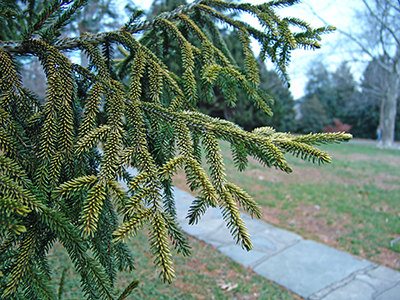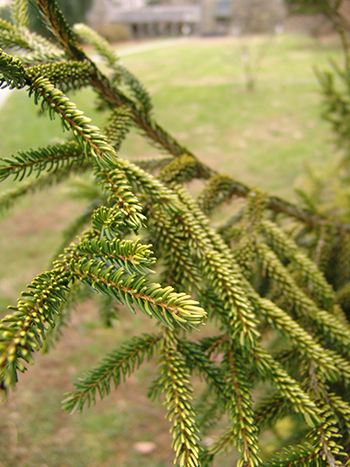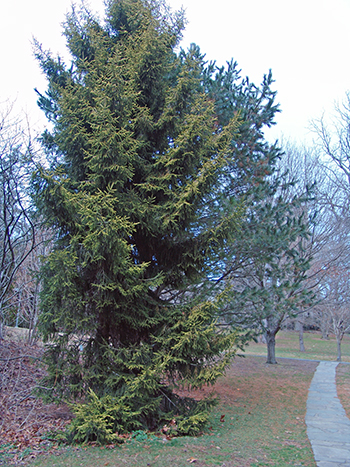
Now that the cold months are now upon us, the leaves have fallen from deciduous plants, we turn a keen eye towards our evergreen plants at the Arboretum. In the simplified winter landscape, the garden becomes a study of form and conifers often take center stage. Conifers are trees and shrubs which bear cones and needle-like leaves and usually have evergreen foliage. A specimen evergreen conifer deserving attention this winter is Picea orientalis ‘Skylands’.
P. orientalis trees, commonly known as Oriental spruce, have a refined look in comparison to the larger needled, wide spreading, and heavily pendulous branches seen on many plants of the Picea genus. With small, glossy, tightly whorled needles, small cones, compact and semi-pendulous branching, trees of this species keep a very neat appearance.

The P. orientalis ‘Skylands’ cultivar boasts short, tight yellow foliage, and a graceful form making it an ideal specimen tree. photo credit: R. Robert
The P. orientalis ‘Skylands’ cultivar boasts short, tight yellow foliage, and a graceful form making it an ideal specimen tree. New growth in the spring emerges in a dramatic bright yellow, fading to rich gold with dark green foliage in the plant’s interior. This sharply contrasts with the red cones of spring.
While Picea orientalis ‘Skylands’ can grow in full sun or part shade, foliage color brightens in more sun and becomes softer lime green with more shade. The color remains an attractive gold throughout the winter. Like many yellow-needled conifers, the needles of P. orientalis ‘Skylands’ can burn in the hot summer sun and young plants in full sun should receive ample watering. P. orientalis ‘Skylands’ is hardy to zone 4, but a site protected from drying winter winds is recommended in northerly climates. Exposure to strong winter winds can cause browning of needles.
P. orientalis ‘Skylands’ has a broad, upright conical form, and a slower growth rate than the P. orientalis species, eventually reaching a size of 25’ tall by 15’ wide. The smaller mature size and reduced growth rate of P. orientalis ‘Skylands’ make this conifer suitable for the garden with limited space. Mature specimens will eventually reach a size of 25’ tall by 15’ wide.

While Picea orientalis ‘Skylands’ can grow in full sun or part shade, foliage color brightens in more sun and becomes softer lime green with more shade. photo credit: R. Robert
This conifer is adaptable, performing well in the heat and humidity of the Philadelphia area, but also tolerating temperatures much lower than we experience in southern Pennsylvania. P. orientalis ‘Skylands’ prefers rich, moist, well drained soil, but such conditions are not essential. Water needs for this spruce are average, and typical rainfall on the East Coast should provide sufficient moisture. Once established, P. orientalis ‘Skylands’ can tolerate moderate drought and a wide range of soil types, including dry and rocky conditions. Few pest and disease problems exist for this tree.
A favorite plant of mine for year-round color, I planted P. orientalis ‘Skylands’ in zone 5a Vermont at my family home. It has grown in full sun and without any winter wind protection. Approximately 8’ tall after 5 years, it remains in great health. Consider using P. orientalis ‘Skylands’ as a focal point in your landscape, a planting in the presence of other conifers, and using plants with red, blue or dark green foliage nearby to accentuate the yellow needles. Find our speciemen next to the Faulkner Tennis Courts below the Tree Peony Collection to experience this cultivar for yourself.
